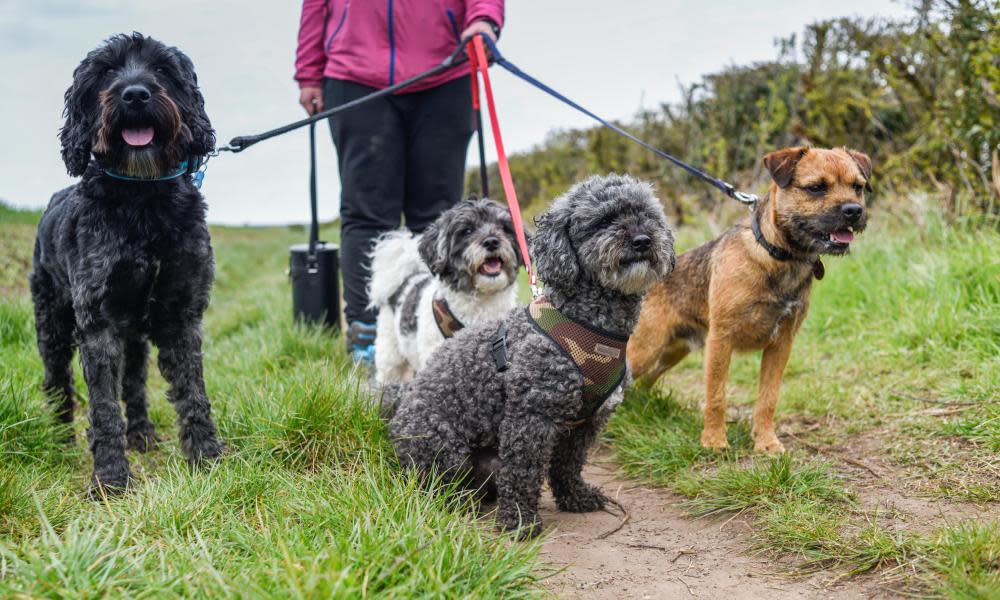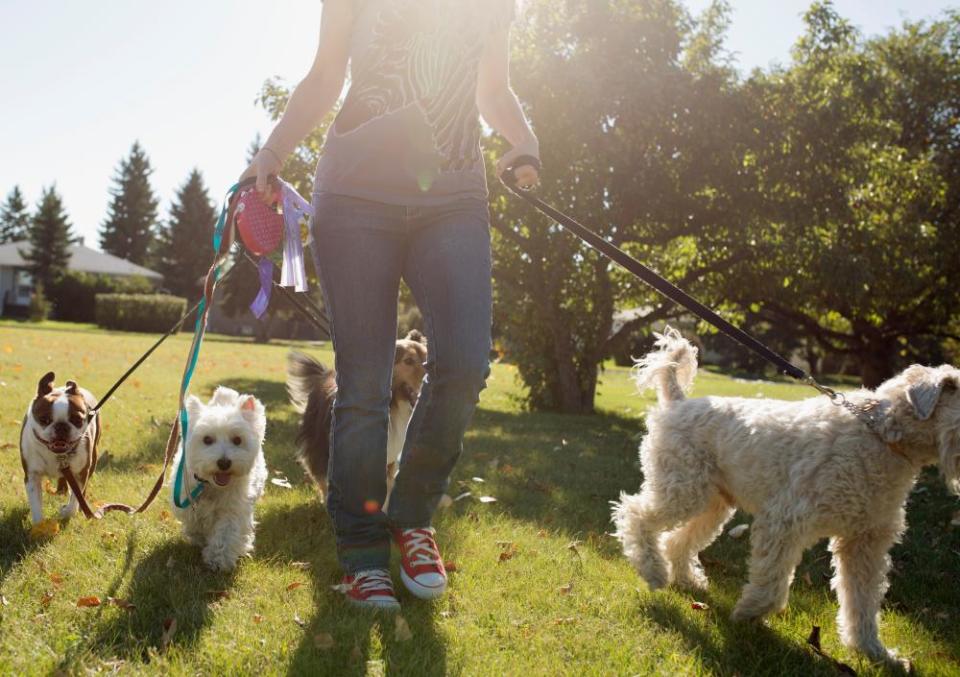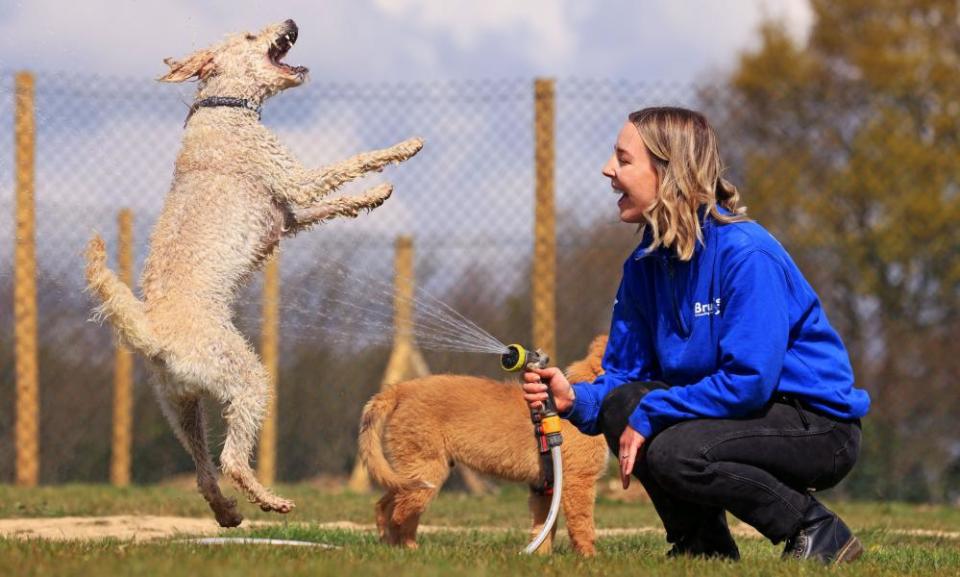Dog daycare: who will look after your pet when you go in to work?

Over the past year, dogs have provided locked-down owners with comfort, company and a reason to head out for long restorative walks. There are 12 million of them in the UK, according to data from the Pet Food Manufacturers’ Association. And because of the coronavirus pandemic, a whole generation of puppies have never spent any time alone, while older dogs have got used to always having someone around. Now that we can leave the house again, that may be about to change.
“Our biggest concern as people start returning to work outside the home is that pets will need to adapt to a very different routine and may experience some anxiety around being separated from the owners they’ve spent every day with during lockdown,” says Daniella Dos Santos, a vet and the senior vice-president of the British Veterinary Association. “Owners should spend time gradually getting pets used to being left alone or in different settings and make sure these experiences are positive.”
Even if you are not going back to the workplace right away, you may be planning days out, so you should consider how your pet will be looked after when you are not around. Dogs should not be left alone for more than four hours at a time, and puppies can only be left for an hour or so.
If you cannot be around, you can get someone to help – it is an expensive business, though, and there are choices to be made.
Dog walkers

A dog walker can help to break up the day by taking your pet out for a toilet break and exercise.
Unlike daycare and boarding facilities, they are not regulated. “Some local authorities require dog walkers to apply for a licence but others don’t, so it’s pretty much a postcode lottery as to whether or not that will be the case,” says Dr Samantha Gaines, a dog welfare expert at the RSPCA.
The Dogs Trust advises meeting potential dog walkers in person to ask about training and experience, how many dogs they walk at once, how they will transport the dog, and their cancellation policy.
If the dog walker will have a set of your keys, you should check what impact this has on your home insurance
Dog walkers typically charge from £10 to £17 for an hour’s walk. What you get for your money will vary. Some dog walkers send photos while on their outings, and some go the extra mile. Those booked through Rover, a pet-sitting service endorsed by the RSPCA, can use an app to map the walk and send details and photos to the owner, along with an update on whether the dog went to the toilet. A bit like Strava but with added bodily function information.
If the dog walker will have a set of your house keys to pick up your pet, you should check what impact this has on your insurance. “Handing keys to someone else not usually resident at your property could have implications on home insurance, especially where evidence of forcible and violent entry is needed in the event of a burglary,” says Malcolm Tarling, a spokesman for the Association of British Insurers. “You should check your home insurance policy and speak to your insurer if unsure.”
Daycare for dogs
Broadly speaking, the main choice is between an individual looking after dogs in their own home, and businesses that run something like a canine creche; both should be licensed. Which is best for you depends on what suits your dog, and your budget.
Daycare costs vary from centre to centre, and typically fall between £20 and £40 a day. Bruce’s Doggy Day Care, which has five centres in London and the home counties, is at the top end of the price scale, and owners must sign up for a minimum of two half-days a week and pay a fixed monthly fee, and give a month’s notice when cancelling the agreement.

At Bruce’s, dogs are split into different groups, separating the large and small dogs. Its founder, Bruce Casalis, says: “We have puppy preschool because puppies have very different needs to adult dogs. They need to rest, they need more meals through the day and they haven’t learned their social skills yet.”
For some dogs, daycare is brilliant fun. “If you’ve got a super-sociable, happy-go-lucky dog, then they’re probably going to be pretty happy being around a bunch of dogs all day,” says Chloe Jackson, a canine behaviourist and training manager at Battersea Dogs & Cats Home. For others, it’s scary: “You need to know what your dog can and can’t cope with. Are they anxious about new people or new spaces? If so, you have to determine whether daycare is the right course of action for your dog.”
If your dog is the nervous type, they might not be accepted at daycare. Under the regulations, dogs should be screened to make sure they are not “afraid, anxious or stressed”, so they don’t pose a danger to other dogs or staff.

A dog-sitter who looks after your pet at their home may be a more suitable choice. Some only look after one dog at a time, others have more; they should never exceed the number specified on their licence. Typically, home daycare costs are between £15 and £30 a day.
You can search for and contact potential carers directly but booking through a dedicated service may save some time and trouble. With Rover, for example, you enter the dates you need help with and information about your pet, and the site’s algorithm will bring up the profiles of suitable, verified people in your neighbourhood.
“A real person reviews every single new profile manually,” says Rover’s Thea Mathias. Sitters must have ID checks and agree to abide by any relevant regulations. Payments are made through Rover, which charges a 15% booking fee, up to a maximum of £49; a £1 donation goes to the RSPCA for each first-time booking. As part of the deal, the Rover Guarantee promises to reimburse members for “costs arising from certain injuries or damages that occur during a service booked and paid for through Rover”, essentially providing cover where insurance falls short.
“One of the most important steps is to arrange a meet-and-greet before agreeing anything,” Mathias says. “You need to make sure that you feel comfortable and happy.”
Sharing the love
BorrowMyDoggy connects owners with local dog lovers who don’t have a pup and would like to take care of one, whether on a walk or for daytime dog-sitting or overnight stays. Launched by London-based Rikke Rosenlund in 2012, it has 1 million members covering 99% of postcodes in the UK. It is free to set up a profile but you need to pay for premium membership to contact borrowers and set up sessions. The fee is £44.99 a year for dog owners or £12.99 for borrowers.
“As part of the subscription fee, there is [accident and third-party liability] insurance and access to a 24/7 vet line. We also verify all of our members and check them against the electoral role,” Rosenlund says. “But the most important thing is meeting up locally, getting to know each other.”
Pauline Sherman needed help looking after Barney, her retriever, when she began a new job at the Covid testing centre in Tangmere, West Sussex, last year. She had been using a dog walker twice a day but Barney spent more time alone than she wanted. “I put up a profile with a photo of Barney and information about him, the fact he’s a very energetic dog and needs lots of attention, exercise and mental stimulation to be happy,” she says.
Two potential borrowers didn’t work out but then Lauren Richardson made contact. She and her partner, Steve, had just bought their first home. “Both our families always had pets, and it felt like a dog was the thing that was missing but the timing wasn’t right to get our own,” Richardson says. “And then lo and behold, we found Barney’s profile.”
They met up and Lauren and Barney “clicked immediately”, Sherman says. She and Richardson became friends, too. Now, when Sherman works three long days in a row, she drops off Barney on the first day and picks him up after her last shift. “I know that he gets lots of attention and love, which is what he needs. And while finances were not my first priority, using a dog walker was costing about £265 a month. Here, no money changes hands and I know Lauren looks after him because she enjoys his company.”
For Richardson, whose job is home-based, it is the perfect arrangement: “It means I get out walking, which gets me away from the screen. And when you’re having a rubbish day, it’s nice because you can just cuddle up to the dog. It takes that stress away.”
Watching from afar, plus toys to keep dogs occupied
“People talk about Velcro dogs, following their owners from room to room and not wanting to be on their own,” says the RSPCA’s Gaines. “Regardless of all the daycare options are out there, dogs do need to learn to spend time by themselves. It’s such a critical life skill.”
Gaines suggests leaving a camera and filming your dog to see how it reacts once the door has closed. You can even watch your dog from afar and entertain it at the same time, with one of a number of treat-dispensing cameras on the market, such as the Furbo or the Petcube Bites 2. Petcube’s makers claim it is the “perfect assistant for busy pet parents”, allowing you to watch and talk to your pet on your smartphone with two-way audio, and remotely fling out treats to keep your dog’s spirits up.
To distract and entertain your dog while you are not there, Battersea’s Jackson recommends LickiMat, a range of textured mats designed to give them a slow-release treat. You load up the mat with something spreadable (LickiMat recommends Greek yoghurt or peanut butter) and the dog takes its time to lick the mat clean. They cost from £5 to £12.50.
Your dog may shred your slippers in seconds but Kong dog toys are made from stronger stuff. The Kong Classic toy (£5) is a hollow rubber snowman-shaped affair that you stuff with something tasty (cream cheese works well). If you’re lucky, your dog will be occupied for some time trying to empty it. Try the Battersea Dogs & Cats Home online shop for more toys.


